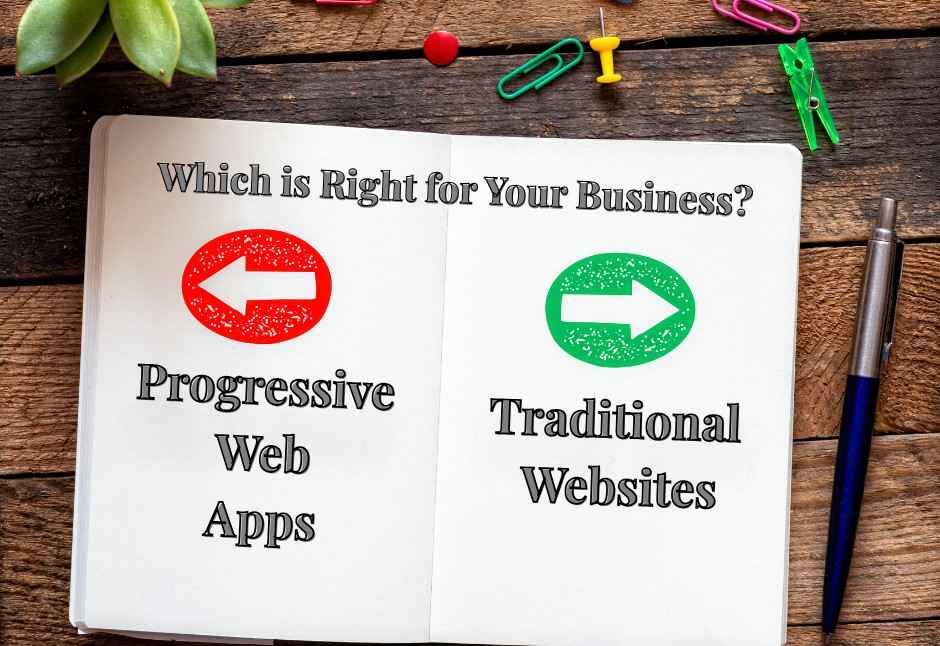
Alright, if you’ve been following the digital world lately, you may have heard the term “progressive web apps” mentioned a few times.
Perhaps the term came up at a networking event you attended. Perhaps it was mentioned in a LinkedIn post that you quickly glanced at. Like many small business owners, you were undoubtedly thinking, “Wonderful.” One more tech jargon term.
The problem is that progressive web apps are more than just a fad. In actuality, they are changing how companies view their internet presence. And you should be mindful of that.
What is this trend all about, then? Do you continue to use the traditional website or is it time to make the switch to a PWA? Well, let’s just keep things simple and omit all the fancy words.
Could you please explain what a Progressive Web App is?
Right, so first things first. A progressive web app (or PWA, for those of us that love an acronym) is essentially a website but in the form of a mobile app. It works offline and sends push notifications; it can even be installed on your phone’s home screen without going through the Apple App Store or Google Play Store.
Think of it as the lovechild between a traditional website and a mobile app… their baby will be PWA. What you get is the reach and immediacy of a website with the function of a native app.
Sounds pretty appealing, doesn’t it? But before we get ahead of ourselves, let’s have a good look at what you’ve got to work with here.
Traditional Websites: The Tried and True Option
There’s a reason that old-school websites have stuck around. They work.
When it comes to managing a business, the well-curated website is your digital shopfront. At Slinky Web Design, we have been designing websites since 2000, and we have seen firsthand how a good website can revolutionise an online presence for any business.
Traditional websites are brilliant for:
- Information delivery: It’s great to get your services, story, and contact details out there. Simple and effective.
- Search engine presence: Google is in love with websites. For more than two decades, our WashTrends digital marketing experts have worked to get local businesses ranking where they deserve.
- Affordable options: There are some practical, professional options for people who don’t want to spend too much.
- Simple to Maintain: It’s easy to keep updated with WordPress and our Maintenance Packs.
But traditional websites have their limitations. They’re not so great at functioning offline. On mobile, they can feel clunky if not optimised properly – and since the majority of worldwide web traffic is now on mobile, that does matter.
They also can’t perform those fancy app-like things users are growing to expect.
Progressive Web App Benefits: What Makes Them Special?
So here’s why you should be considering PWAs right now.
There’s been a heated debate for years about whether a mobile app is better than a website. Do you invest in an expensive native app?
Do you stay with a mobile-responsive site? PWAs basically said “why choose?” and gave us something in the middle.
Here’s what each brings to the table:
They Work Offline (Sort Of)
This is arguably the most salient aspect. A PWA can cache content, so it will be available even if your internet connection is spotty. Or non-existent. Anyone who has attempted to load a website from Telstra’s mobile network in regional WA knows how useful this technique is.
Your customers can shop for your products, read your content, or use your service without requiring a perfect connection at all times. That’s powerful.
They’re fast. Really fast.
Speed matters. No one has the patience to wait for pages to load anymore. PWAs are developed to be blazing fast, as they persist resources on the user’s device. The initial load may take a little time, but afterwards, the loading speed is near-instant. Near-instant.
The performance difference is significant. As the W3C Web Performance Working Group, responsible for creating standards to measure web application performance, points out, PWAs can deliver 2-3x faster load times on repeat visits than regular websites due in part to aggressive caching strategies.
Looking to increase the speed of your ordinary website? Our guide on how to design websites that load quickly contains actionable advice you can start using today. And given that Google rewards quick websites with higher positions in search, that’s a double win.
Push Notifications Without the App
You need to reach your customers with updates, offers, and reminders. With an old-fashioned website, you’d have email marketing or social media. Using a PWA, you can send push notifications to their devices directly – the same way as with an actual app.
That’s a game-changer for enterprises that depend on timely interactions with their customers.
Install It Like an App
With just a tap, users can put a PWA on their home screen. No app store. No lengthy download. There is no begging for access to their camera, contacts, or firstborn child. Just a plain old “add to home screen” and voilà, it’s there, with its own icon and everything.
This type of feature is a big deal for user engagement. When your store exists on someone’s phone, you’re going to come to mind far more regularly.
One Version, Every Platform
And here’s where business starts to get genuinely interested in PWAs. You’re not building multiple versions of your app for iOS, Android and desktops. You are creating one thing that just works everywhere.
Think about the cost savings. Consider the maintenance headaches you skirt. Instead of maintaining three separate codebases, you have but one. That’s a huge advantage for small and medium businesses.
The PWA vs Website Showdown: The Real Differences
Let’s get concrete with how they compare to one another. If you’re trying to choose between them, these are the distinctions that will actually influence your business:
- User Experience: PWAs are more responsive and app-like. On mobile, traditional websites can feel slow. Read more about the differences between mobile design and standard web design.
- Development Cost: Conventional websites are less expensive to start with. PWAs are more expensive upfront but cost-effective if you were about to build both a website AND an app.
- SEO: Everything else takes a backseat to traditional websites for search. PWAs, too, can be optimised but will require more effort.
- Maintenance: PWAs require a higher degree of technical skill, but you are maintaining only one code base. Old-fashioned websites are easier to maintain.
- Browser Support: All websites work everywhere. PWAs are improving, but on iOS, Safari doesn’t fully support all the features.
By considering these in conjunction with your business requirements and customer habits, you get a deeper understanding of which option might work for you.
So, Which One Should You Choose?
At this point, you might expect me to provide a definitive answer, right? And tell you for sure whether to stick with a traditional website or dive into progressive web apps?
You will be sorry to hear that the answer is ‘it depends’.
You should use a traditional website when:
- You’re a small business that needs something in place quickly and on the cheap.
- Your customers primarily engage with you during business hours and open wifi.
- Content delivery is what you strive for – i.e., professional services, tradies, and the local yokel shop.
- Your SEO is important, so don’t try anything else.
But the traditional websites that we’ve built for Perth businesses at Slinky Web Design are numbering in the hundreds, and they’re doing a great job too. Mayoo offers a straightforward solution for various needs.
Consider a PWA if:
- Your customers want access on the go, where they may not have good reception.
- You ‘re looking to Notify Your Customers to keep them engaged.
- Running an eCommerce site where customer experience is synonymous with sales.
- You were going to build a website and a mobile app anyway.
- You’ve got repeat users who would love fast, app-like access.
Here’s what most people don’t know: You are not obligated to decide this and have it remain your decision forever.
This is ideal for most businesses that begin with a typical website and as their requirements scale, they can add PWA functionality to their stack. It’s not always a strict choice between one option or the other.
What About a Hybrid Approach?
Here’s a consideration that most people don’t think about: You don’t have to make it either/or forever.
Start with a traditional website that is well-designed, robust, and easy to navigate. Get your SEO working. Build your customer base. Once your business has matured and you understand its requirements, enhance it with PWA features. Add offline functionality. Enable push notifications. Make it installable.
In fact, many businesses are currently doing this. They are not tearing everything out and beginning again. They’re transforming their existing web presence to utilise progressive web app technology in locations that make sense.
Making the Decision for Your Business
At the end of the day, your site, traditional or PWA needs to do a job. It must attract customers, explain your business, and facilitate transactions.
Don’t rely solely on technology for its own sake.
Ask yourself:
- Who are my clients and how do they want to communicate with companies such as mine?
- What am I attempting to address online?
- What will be my budget, not just for development but to keep it going?
- Where do I want my business to be in three years?
- What are my competitors doing? (Not to mimic them, but to grasp the lay of the land.)
In some cases, the shiniest, latest in technology isn’t what you want. Occasionally it absolutely is. The trick is to figure out what the right decision for your business actually is without falling victim to fads.
Getting Professional Help
Whether you opt for a regular old website or a progressive web app, designing and building it in the right way is super important. A bad PWA is worse than a good traditional site, and vice versa.
At Slinky Web Design, we can do both. We’ll talk to you, figure out what your business really requires, and suggest an option that’s right.
Here’s what really matters: the technology is not nearly as important to the decision as the strategy behind it. If you have the best PWA in Perth, but it doesn’t solve your customers’ problems well, why does this matter?
Final Thoughts
The PWA vs website debate isn’t settling any time soon. Progressive web apps have features regular websites can’t offer, but they’re not always the right choice for everyone.
There are still excellent, time-tested sites that serve the vast majority of businesses just fine. They’re not obsolete — they are something you can keep in your toolkit.
The best advice? Focus on your customers. What do they need? What kind of relationships do they want with you? Answer those questions up front, and the decision is a lot more obvious.
Still not sure? Contact us for our phone number on (08) 6102 1222. No haggling, no tech talk — just real advice from folks who’ve been at this company for more than two decades.
You’re too valuable online to leave it up to fate. Let’s make sure you get that right.










